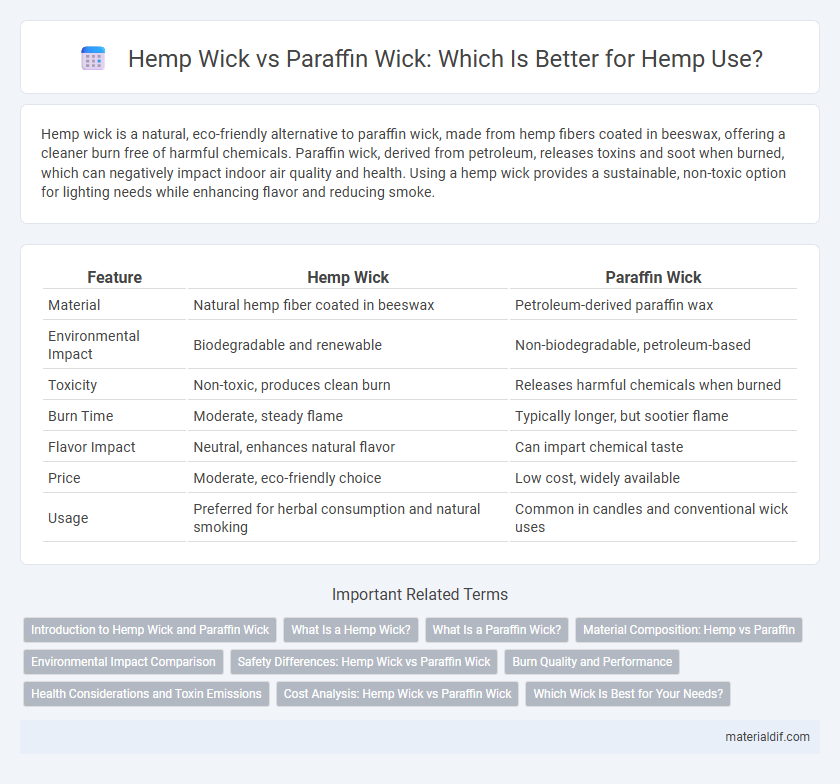Hemp wick is a natural, eco-friendly alternative to paraffin wick, made from hemp fibers coated in beeswax, offering a cleaner burn free of harmful chemicals. Paraffin wick, derived from petroleum, releases toxins and soot when burned, which can negatively impact indoor air quality and health. Using a hemp wick provides a sustainable, non-toxic option for lighting needs while enhancing flavor and reducing smoke.
Table of Comparison
| Feature | Hemp Wick | Paraffin Wick |
|---|---|---|
| Material | Natural hemp fiber coated in beeswax | Petroleum-derived paraffin wax |
| Environmental Impact | Biodegradable and renewable | Non-biodegradable, petroleum-based |
| Toxicity | Non-toxic, produces clean burn | Releases harmful chemicals when burned |
| Burn Time | Moderate, steady flame | Typically longer, but sootier flame |
| Flavor Impact | Neutral, enhances natural flavor | Can impart chemical taste |
| Price | Moderate, eco-friendly choice | Low cost, widely available |
| Usage | Preferred for herbal consumption and natural smoking | Common in candles and conventional wick uses |
Introduction to Hemp Wick and Paraffin Wick
Hemp wick, made from natural hemp fibers coated in beeswax, offers a cleaner, chemical-free burning alternative to paraffin wicks, which are derived from petroleum products. Unlike paraffin, hemp wick produces less soot and fewer toxins, making it a healthier choice for lighting candles, cigarettes, and other applications. The sustainable nature of hemp also appeals to eco-conscious consumers seeking environmentally friendly options in wick materials.
What Is a Hemp Wick?
A hemp wick is a natural alternative to paraffin wicks, made from hemp fibers coated in beeswax, providing a clean and chemical-free burn. Unlike paraffin wicks derived from petroleum, hemp wicks produce less harmful smoke and toxins, making them popular for health-conscious users. Their sustainable, biodegradable composition supports eco-friendly practices, distinguishing them from conventional paraffin options.
What Is a Paraffin Wick?
A paraffin wick is a common type of candle wick coated with paraffin wax, a petroleum-derived substance that helps regulate the burning rate and maintain a steady flame. This wick produces a consistent light but can emit harmful chemicals such as toluene and benzene when burned, raising concerns about indoor air quality. Compared to hemp wicks, which are natural and biodegradable, paraffin wicks are less environmentally friendly and may pose health risks due to toxic emissions.
Material Composition: Hemp vs Paraffin
Hemp wicks are made from natural hemp fibers coated in beeswax, providing an eco-friendly, biodegradable alternative to conventional wicks. Paraffin wicks are derived from petroleum-based paraffin wax, which is a synthetic material linked to environmental pollution and potential health concerns due to combustion byproducts. Choosing hemp wicks supports sustainable sourcing with fewer toxic emissions, while paraffin wicks rely on fossil fuels and release harmful substances when burned.
Environmental Impact Comparison
Hemp wicks offer a significantly lower environmental impact compared to paraffin wicks due to their renewable and biodegradable nature, derived from sustainably grown hemp plants. Paraffin wicks, made from petroleum-based byproducts, contribute to pollution and rely on non-renewable fossil fuels, leading to higher carbon emissions during production and use. Choosing hemp wicks reduces reliance on fossil fuels and supports eco-friendly practices, promoting a cleaner, sustainable alternative in wick options.
Safety Differences: Hemp Wick vs Paraffin Wick
Hemp wicks offer a safer alternative to paraffin wicks due to their natural, chemical-free composition, reducing inhalation of toxic fumes during use. Paraffin wicks, derived from petroleum, release harmful carcinogens like toluene and benzene when burned, posing health risks. Choosing hemp wicks enhances combustion safety by producing cleaner smoke with fewer hazardous byproducts.
Burn Quality and Performance
Hemp wick offers a cleaner burn compared to paraffin wick, producing less soot and harmful fumes due to its natural, untreated fibers. The slow, steady flame of hemp wick provides consistent performance without the chemical residues associated with paraffin, which is a petroleum byproduct. Users seeking a more eco-friendly and health-conscious option often prefer hemp wick for its superior burn quality and reliable ignition.
Health Considerations and Toxin Emissions
Hemp wicks are made from natural hemp fibers coated in beeswax, producing minimal toxins and reducing harmful inhalants compared to paraffin wicks, which are petroleum-based and release carcinogenic compounds when burned. Studies highlight that burning paraffin wicks emits volatile organic compounds (VOCs) such as toluene and benzene, linked to respiratory issues and long-term health risks. Choosing hemp wick supports cleaner combustion, lowering exposure to potentially toxic smoke and promoting safer inhalation practices.
Cost Analysis: Hemp Wick vs Paraffin Wick
Hemp wicks generally have a higher upfront cost compared to paraffin wicks due to their natural, organic materials and sustainable production methods. Paraffin wicks, made from petroleum byproducts, are typically cheaper but may incur hidden costs related to environmental impact and potential health risks from toxic emissions. When analyzing long-term expenses, hemp wicks often prove more economical as their durability and eco-friendly nature reduce the need for frequent replacements and additional health-related costs.
Which Wick Is Best for Your Needs?
Hemp wicks offer a natural, chemical-free alternative to paraffin wicks, burning cleaner with minimal soot and a steady flame ideal for herbal consumption and eco-conscious users. Paraffin wicks, derived from petroleum, tend to produce more harmful toxins and an inconsistent flame, which may affect taste and health. Choosing hemp wick provides better flavor preservation and a safer smoking experience, making it the preferred option for health-conscious individuals.
Hemp wick vs Paraffin wick Infographic

 materialdif.com
materialdif.com